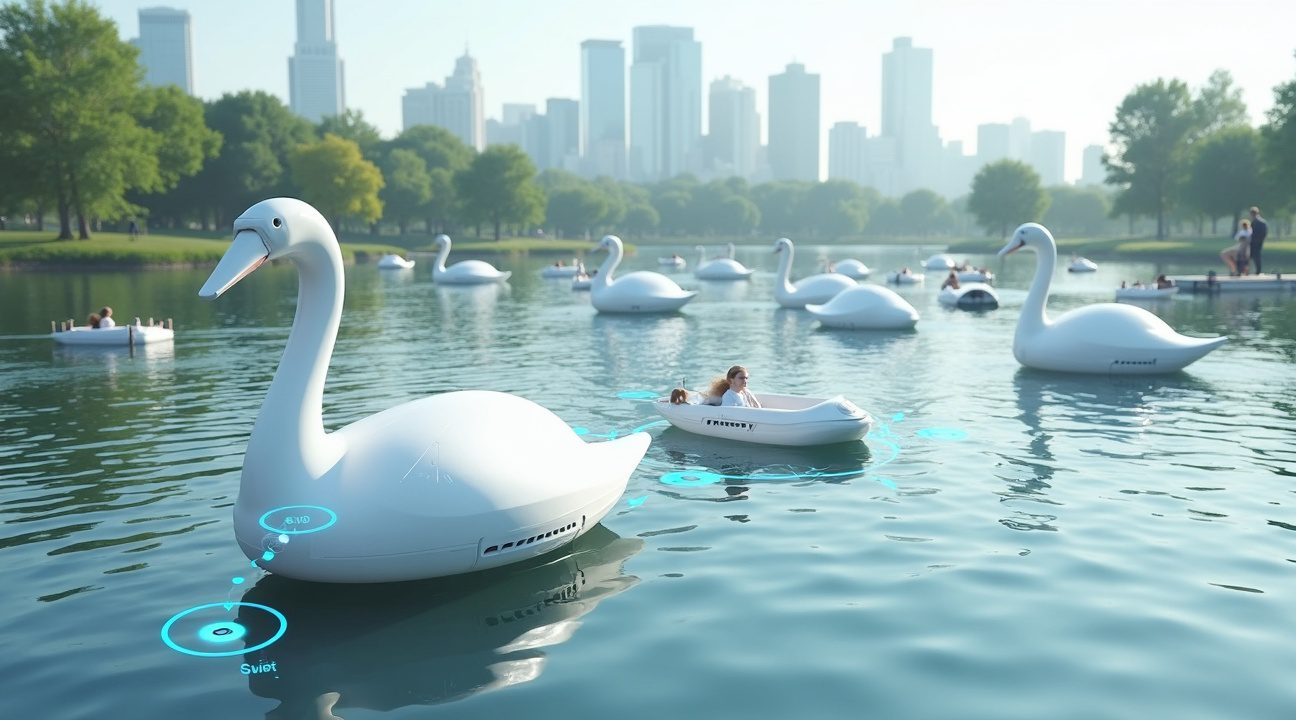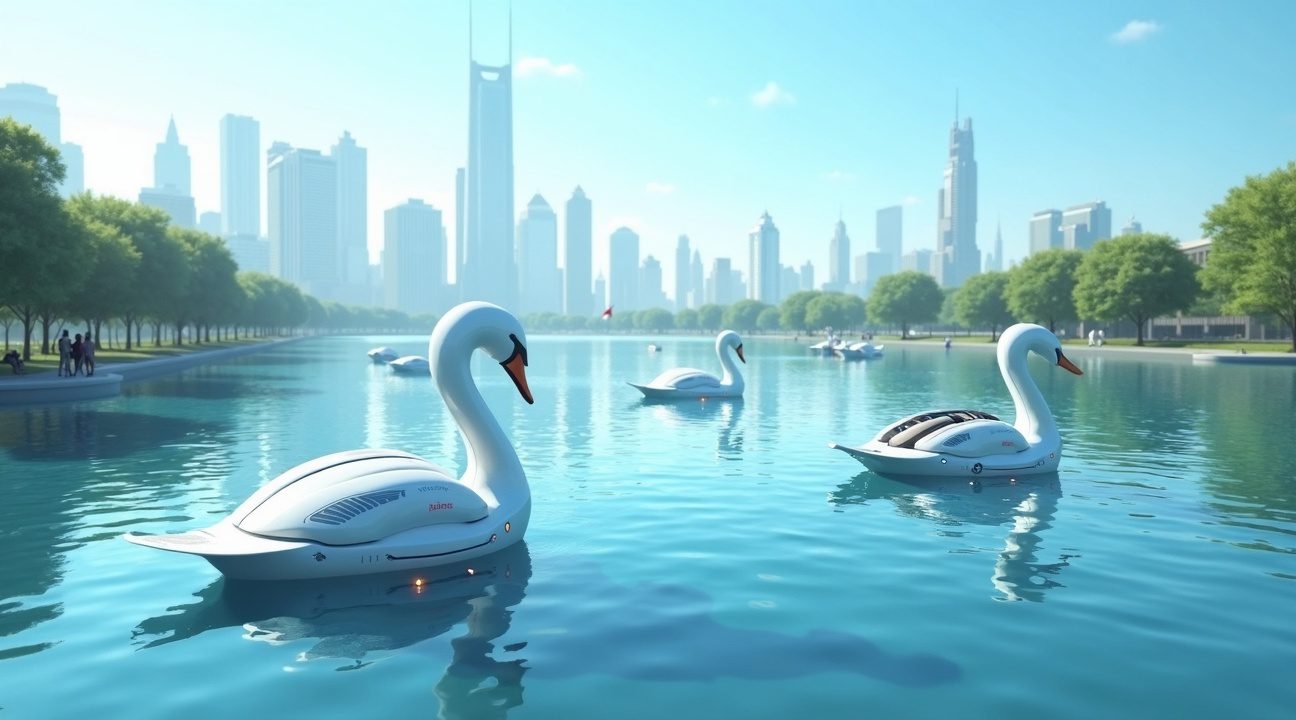Singapore’s Smart Water Assessment Network (S.W.A.N.) project has introduced an innovative approach to water quality monitoring by deploying five AI-powered robotic swans across the country’s lakes and reservoirs, providing real-time environmental surveillance while blending naturally into aquatic ecosystems.
Key Takeaways
- Five robotic swans patrol Singapore’s water bodies autonomously, monitoring pH, oxygen levels, and pollutants in real-time using advanced sensor technology.
- The robotic swans transmit data wirelessly to cloud-based systems, enabling swift responses to potential water quality issues and replacing slower manual methods.
- Each robotic swan resembles natural waterfowl, minimizing disruption to wildlife and human activity while conducting continuous aquatic surveillance.
- This technology surpasses manual sampling, offering comprehensive coverage, even in hard-to-reach areas of lakes and reservoirs.
- Other countries are showing growing interest in implementing similar robotic swan systems for their own water monitoring programs.
A Revolutionary Step in Environmental Monitoring
The S.W.A.N. initiative exemplifies how robotic technology is transforming traditional environmental monitoring. Previously, human technicians manually collected water samples, often missing critical fluctuations between intervals. These robotic swans now fill in those gaps, operating 24/7 and offering unparalleled oversight of aquatic environments.
Advanced Sensor Technology
Each robotic swan is equipped with advanced sensor arrays that simultaneously measure temperature, chemical contamination, and biological parameters critical to ecosystem health. Instead of periodic sampling, the devices allow for real-time, continuous water quality data collection, permitting rapid identification of pollution or ecological disturbances.
Biomimetic Design and Integration
The swans’ design goes beyond aesthetics. Their lifelike appearance ensures seamless integration within natural environments, minimizing wildlife disturbances that could affect water quality. Since animals remain undisturbed, data collected is more accurate and reflective of true ecosystem conditions.
Cloud Processing and Rapid Response
Authorities receive real-time information via cloud-connected platforms. These data systems trigger immediate alerts during contamination events, allowing for prompt intervention. This reduces environmental impact and protects public health, shortening emergency response times from hours to minutes.
Minimal Maintenance Needs
Each swan operates autonomously over extended periods, only needing occasional battery changes and sensor recalibrations. Autonomous navigation enables them to follow designated paths while avoiding obstacles and shallow zones, minimizing human oversight.
Global Implications and Adoption
Singapore’s success with the S.W.A.N. model has inspired global interest. Several European nations have already initiated pilot testing of similar systems. The flexible design makes it suitable for varied environmental and geographical conditions, allowing for adaptation in water bodies of all types and sizes across the world.
To explore more about Singapore’s innovation, you can visit the official PUB Singapore water agency website for additional insights into the S.W.A.N. initiative and other water management technologies.
https://www.youtube.com/watch?v=0_Ks3CFKPM5j
Five AI-Powered Swans Now Patrol Singapore’s Waters, Monitoring Quality in Real Time
Singapore has deployed five sophisticated robotic swans across its lakes and reservoirs through the Smart Water Assessment Network (S.W.A.N.) project. These artificial waterfowl represent a cutting-edge approach to environmental monitoring, combining advanced sensor technology with biomimetic design to create an unobtrusive yet powerful water quality surveillance system.
Seamless Integration with Natural Environments
The robotic swans are designed to closely resemble actual swans, allowing them to blend seamlessly into their surroundings. This careful attention to natural appearance ensures minimal disruption to local wildlife and human activity while the devices conduct their monitoring duties. Researchers at the National University of Singapore, working in collaboration with PUB, Singapore’s National Water Agency, developed these units to function as silent guardians of water quality.
These robotic units move gracefully through Singapore’s water bodies, their sensors continuously collecting critical data about water conditions. Much like how advanced robotics continue to push boundaries in various fields, these aquatic monitors represent innovation in environmental technology. Each swan houses sophisticated monitoring equipment capable of measuring pH levels, dissolved oxygen content, and detecting various pollutants that could threaten water quality.
Data gathered by the robotic swans is transmitted wirelessly in real time to cloud-based systems accessible by water management agencies. This immediate data transfer enables rapid response to water quality issues, allowing authorities to address problems before they escalate into larger environmental concerns. The system’s responsiveness mirrors the speed we’ve seen in other technological advances, from flying vehicles to aerospace innovations.
Water management professionals can access comprehensive dashboards showing real-time readings from all five deployed units. These systems provide instant alerts when parameters fall outside acceptable ranges, triggering immediate investigation protocols. The continuous monitoring capability represents a significant advancement over traditional water testing methods, which typically require manual sampling and laboratory analysis.
The robotic swans patrol different sections of Singapore’s water infrastructure, ensuring comprehensive coverage across multiple reservoirs and lakes. Their autonomous operation eliminates the need for constant human supervision while maintaining consistent data collection schedules. Each unit operates independently, following programmed patrol routes while adapting to environmental conditions and obstacles.
Battery life and maintenance schedules are carefully managed to ensure uninterrupted operation. The units return to designated charging stations automatically, minimizing downtime and ensuring continuous water quality surveillance. This level of automation reflects broader trends in technology, similar to innovations we’ve witnessed in areas ranging from gaming technology to space exploration.
The S.W.A.N. project demonstrates Singapore’s commitment to leveraging technology for environmental protection. By deploying these AI-powered monitoring systems, the city-state ensures proactive water quality management rather than reactive responses to contamination events. The project’s success could serve as a model for other urban centers seeking innovative approaches to environmental monitoring.
Future expansions of the program may include additional robotic units and enhanced sensor capabilities. The data collected by these artificial waterfowl contributes to Singapore’s broader smart city initiatives, providing valuable insights for urban planning and environmental policy decisions. Like other remarkable discoveries in nature, from deep-sea creatures to technological marvels, these robotic swans represent humanity’s ongoing quest to understand and protect our environment through innovation.
https://www.youtube.com/watch?v=0_Ks3CFKPM5jqM
Advanced Sensors Track pH, Oxygen Levels, and Hidden Pollutants
I’ve observed how Singapore’s robotic swans employ a sophisticated array of sensors that continuously monitor critical water quality parameters across the city-state’s lakes. Each mechanical bird carries cutting-edge detection equipment designed to track five essential indicators that determine water safety and ecosystem health.
Core Water Quality Parameters
The sensor systems integrated into these robotic swans focus on specific measurements that provide comprehensive water quality assessment:
- pH levels measure water acidity and alkalinity, detecting chemical imbalances that could harm aquatic ecosystems
- Dissolved oxygen sensors track oxygen concentrations essential for fish survival and overall aquatic health
- Turbidity detectors assess water cloudiness caused by suspended particles and sediments
- Chlorophyll monitors evaluate algae and plant life concentrations within the water column
- Pollutant sensors identify contamination sources and harmful substances before they spread
These sensors work simultaneously, creating a real-time picture of water conditions that would be impossible to achieve through traditional manual testing methods. The data collection happens continuously as the robotic swans patrol designated areas, covering more ground than human technicians could manage in weeks.
Critical Monitoring During High-Risk Periods
The sensor technology proves especially valuable during Singapore’s dry weather periods when algal blooms present increased risks to water safety. During these times, the robotic swans intensify their monitoring activities, detecting early warning signs of algae proliferation before it reaches dangerous levels.
I find it fascinating how these automated systems can identify subtle changes in chlorophyll concentrations that indicate the beginning stages of algal bloom formation. The early detection capability allows environmental managers to implement preventive measures before water quality deteriorates significantly. This proactive approach represents a significant improvement over reactive water management strategies that only address problems after they become visible to the naked eye.
The dissolved oxygen sensors play a particularly crucial role during these periods, as algal blooms can rapidly deplete oxygen levels and create dead zones where aquatic life cannot survive. By tracking these changes in real-time, the robotic swans provide essential data that helps maintain ecological balance in Singapore’s water bodies.
Much like how robots are becoming more sophisticated in various applications, these aquatic monitoring systems demonstrate remarkable technological advancement in environmental protection. The integration of multiple sensor types into a single mobile platform represents a breakthrough in water quality management.
The pH monitoring capabilities ensure that water remains within acceptable ranges for both human use and aquatic life. Sudden pH changes can indicate pollution events or natural processes that require immediate attention. The robotic swans’ ability to detect these fluctuations instantly provides environmental managers with the information needed to respond quickly to potential threats.
Turbidity measurements help identify sediment disturbances, erosion events, or pollution sources that make water cloudy and potentially unsafe. High turbidity levels can indicate everything from construction runoff to sewage discharge, making this parameter essential for comprehensive water monitoring.
The pollutant detection systems represent perhaps the most advanced aspect of these robotic monitoring platforms. These sensors can identify various contaminants including heavy metals, chemical pollutants, and other harmful substances that might enter the water system through industrial discharge or urban runoff. Early detection of these pollutants enables rapid response measures that can prevent widespread contamination.
This comprehensive sensor package transforms each robotic swan into a mobile water quality laboratory, providing data quality that rivals traditional testing methods while offering unprecedented coverage and frequency of measurement. The technology represents a significant step forward in environmental monitoring, combining innovative engineering with practical environmental management needs.

How These Robot Swans Navigate and Collect Data Autonomously
The robotic swans operate with impressive independence, covering expansive water bodies without requiring constant human oversight. I find their autonomous capabilities particularly remarkable, as they can patrol entire lakes while systematically collecting water quality measurements. When specific monitoring needs arise, operators can take manual control to direct the units toward targeted sampling locations or perform necessary maintenance procedures.
Advanced Connectivity and Real-Time Data Processing
These aquatic robots leverage IoT connectivity combined with local WiFi networks to transmit information instantly to cloud-based systems. Water quality experts can access pH readings, oxygen levels, and pollutant data as soon as the sensors collect it, enabling rapid response to any concerning changes. The seamless data flow eliminates delays that traditional manual sampling methods often create, providing authorities with up-to-the-minute environmental insights.
Remote commanding capabilities allow operators to direct specific swans toward areas requiring detailed investigation. They can request targeted water samples for laboratory analysis or position units at particular coordinates where environmental concerns have emerged. This flexibility proves invaluable during incidents like unexpected contamination events or when monitoring seasonal changes in water chemistry.
Durability Features for Public Waterway Operations
The engineers designed these robotic swans with reinforced construction to handle the challenges of operating in public spaces. Their sturdy build allows them to withstand minor impacts from recreational boats, kayaks, and other watercraft without sustaining damage that would compromise their monitoring functions. This resilience ensures continuous operation even in busy recreational areas where human activity is common.
Singapore’s lakes see significant recreational use, making collision resistance essential for reliable long-term deployment. The swans’ ability to maintain functionality after minor bumps keeps monitoring programs running smoothly without frequent repairs or replacements. While other autonomous vehicles face similar durability challenges, these aquatic units have proven their effectiveness in demanding public environments.
The combination of autonomous navigation, instant data connectivity, and robust construction makes these robotic swans powerful tools for continuous water quality monitoring. Their ability to operate independently while remaining responsive to remote commands provides environmental managers with unprecedented flexibility in maintaining Singapore’s aquatic ecosystems.

Why Singapore Abandoned Traditional Water Testing Methods
Singapore’s transition away from conventional water quality monitoring methods reflects the limitations that plagued their previous systems. I’ve observed how fixed monitoring stations, while providing consistent data collection points, severely restricted coverage across the nation’s numerous water bodies. These stationary installations could only monitor specific locations, leaving vast areas of reservoirs and lakes unobserved between sampling points.
The Labor-Intensive Challenge of Manual Sampling
Manual sampling by boat presented another significant obstacle that authorities struggled to overcome. I’ve noted how this approach required substantial human resources, with teams regularly venturing out to collect water samples across different locations. Weather conditions frequently disrupted sampling schedules, creating gaps in data collection that could last for days or weeks. The process consumed considerable time and financial resources while delivering relatively infrequent updates about water conditions.
Manual sampling also introduced potential human error factors and safety concerns for personnel working on water bodies. Teams faced challenges accessing remote areas of larger reservoirs, and the physical demands of sample collection limited the frequency and scope of monitoring activities.
Enhanced Coverage Through Advanced Technology
Robotic swans have transformed Singapore’s approach by providing comprehensive coverage that traditional methods couldn’t achieve. I’ve seen how these autonomous devices continuously patrol water bodies, collecting real-time data on pH levels, oxygen content, and various pollutants without human intervention. The technology enables authorities to monitor previously inaccessible areas and maintain constant surveillance across extensive water systems.
The efficiency gains prove remarkable compared to previous methods. These robotic systems operate around the clock, generating continuous data streams that allow for immediate detection of water quality changes. Unlike advanced robotic systems in other applications, these aquatic monitors focus specifically on environmental sensing capabilities.
Response times have improved dramatically since implementing this technology. I’ve observed how authorities can now detect emerging contaminants within hours rather than waiting for scheduled sampling rounds that might occur weekly or monthly. This rapid detection capability allows for swift intervention when pollution events occur, protecting public health more effectively than traditional monitoring systems ever could.
Resource management has become significantly more efficient through automated monitoring. The cost savings from reduced manual labor, combined with improved data quality and frequency, justify the initial investment in robotic technology. Singapore’s water authorities can now allocate human resources to analysis and response activities rather than routine sample collection, maximizing the effectiveness of their environmental protection efforts.
https://www.youtube.com/watch?v=DNtB1fCzIMU
Countries Worldwide Want to Copy Singapore’s Robotic Swan Technology
Multiple nations have taken notice of Singapore’s innovative approach to water quality monitoring, with several countries actively pursuing similar robotic swan programs for their own water bodies. The success of these autonomous aquatic monitors has sparked international interest, as governments recognize the potential for cost-effective, continuous environmental surveillance without human intervention.
Global Interest in Autonomous Water Monitoring
Countries across Europe, North America, and Asia have begun reaching out to Singapore’s research teams to understand the technology behind these graceful robotic monitors. Officials from lake-heavy regions see immediate applications for their own environmental challenges, particularly in areas where traditional monitoring methods prove expensive or logistically difficult. The robotic swans offer a solution that combines advanced sensor technology with an unobtrusive design that doesn’t disrupt natural ecosystems or recreational activities.
Several European nations with extensive lake systems have expressed particular enthusiasm for adapting this technology. Similarly, countries dealing with industrial pollution in waterways view the swans as a proactive monitoring solution that could help identify contamination sources before they become widespread environmental problems.
Enhanced Capabilities and Future Expansion Plans
Researchers continue developing enhanced versions of the robotic swans with upgraded sensor arrays and improved analytical capabilities. Future iterations will feature more sophisticated detection systems capable of identifying specific pollutant types and tracking their movement patterns through water systems. These improvements include:
- Advanced chemical sensors for detecting heavy metals and industrial compounds
- Enhanced GPS tracking systems for precise location monitoring
- Improved battery life and solar charging capabilities for extended operation periods
- Real-time data transmission systems for immediate alert capabilities
- Weather-resistant designs for operation in various climate conditions
The long-term vision involves deploying coordinated fleets of these robotic monitors that can work together to create comprehensive water quality maps. This network approach would allow for systematic coverage of large water bodies while providing redundant monitoring capabilities. Each swan would communicate with others in the fleet, sharing data and coordinating movement patterns to optimize monitoring coverage.
Advanced control systems under development will enable the swans to adapt their monitoring routes based on real-time water quality data, concentrating efforts in areas where problems are detected. This adaptive approach represents a significant advancement over static monitoring stations, as the robotic fleet can respond dynamically to changing environmental conditions.
The technology’s potential extends beyond simple water quality monitoring. Future applications may include tracking wildlife populations, monitoring water temperature variations, and even detecting illegal dumping activities. Just as robots have evolved to perform increasingly complex tasks, these aquatic monitors continue advancing their capabilities.
Countries expressing interest in the technology recognize its potential for addressing various environmental challenges. Urban areas with recreational lakes see applications for maintaining water quality standards for public use. Agricultural regions view the technology as a tool for monitoring runoff and irrigation water quality. Industrial areas consider the swans valuable for early detection of contamination events.
The global adoption potential appears significant as more nations prioritize environmental monitoring and water resource management. The robotic swan technology offers a scalable solution that can be adapted to different water body sizes and environmental conditions. As manufacturing costs decrease and technology improves, widespread international deployment becomes increasingly feasible.
Research teams continue refining the technology while exploring partnerships with international organizations and government agencies. The success of Singapore’s initial deployment provides a strong foundation for global expansion, demonstrating the practical viability of autonomous water quality monitoring systems. This innovative approach to environmental surveillance may soon become a standard tool for water resource management worldwide.

Sources:
Digital Trends: “Singapore has a flock of robo-swans patrolling its waters”
RESET.org: “Singapore’s Latest Addition to the Fight Against Polluted Waters”
Dezeen: “Robotic swans used to monitor quality of Singapore’s reservoirs”
sproboticworks.com blog: “Wow!! Robotic Swan in action!!”
Instagram: “Singapore uses robotic swans to monitor lake water quality…”


